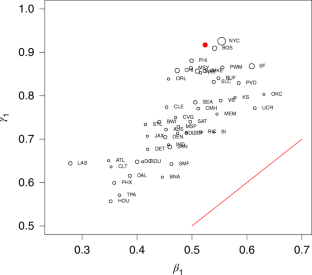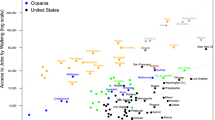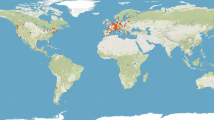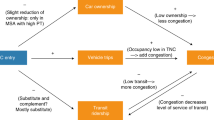Abstract
Transit accessibility to jobs (the ease of reaching a place of work by public transport) affects both residential location and commute mode choice, resulting in gradations of residential land-use intensity and transit (public transport) patronage. We propose a scaling model explaining much of the variation in transit use—the number of transit commuters per km2—and residential land-use intensity with transit accessibility. We find that locations with high transit accessibility consistently have more riders and higher residential density; transit systems that provide greater accessibility and with a larger base for patronage have proportionally greater ridership increase per unit of accessibility. All 48 metropolitan statistical areas in our sample have a scaling factor less than 1, so a 1% increase in access to jobs produces a less than 1% increase in transit riders; the largest cities therefore have higher scaling factors than smaller cities, indicating returns to scale. The models, derived from a new database of transit accessibility measured for every minute of the peak period over 11 million US census-blocks, and estimated for 48 major cities across the United States, find that the number of jobs reachable within 45 minutes of the rider’s base most affect transit rider density. The findings support the idea that transit investment should focus on mature, well-developed regions.
This is a preview of subscription content, access via your institution
Access options
Access Nature and 54 other Nature Portfolio journals
Get Nature+, our best-value online-access subscription
$29.99 / 30 days
cancel any time
Subscribe to this journal
Receive 12 digital issues and online access to articles
$119.00 per year
only $9.92 per issue
Buy this article
- Purchase on Springer Link
- Instant access to full article PDF
Prices may be subject to local taxes which are calculated during checkout



Similar content being viewed by others
Data availability
The transit accessibility data are obtained from the Accessibility Observatory at the University of Minnesota. Block-group accessibility measures are population weighted averages of constituent block values to match the spatial reporting of the mode share data from the US Census Bureau. Working population characteristics come from the 2016 American Community Survey and Longitudinal Employer-Household Dynamics programme’s 2015 Origin-Destination Employment Statistics65,66. Data on mode share are obtained from the 2016 American Community Survey 5 yr estimates which describes commute mode choice between 2012 and 2016. Transit is defined to include walking, ferry, rail (subway and commuter), and bus, trolley and streetcar. Data described in this section are available via public websites.
References
West, G. B., Brown, J. H. & Enquist, B. J. A general model for the origin of allometric scaling laws in biology. Science 276, 122–126 (1997).
Louf, R. & Barthelemy, M. How congestion shapes cities: from mobility patterns to scaling. Sci. Rep. 4, 5561 (2014).
Depersin, J. & Barthelemy, M. From global scaling to the dynamics of individual cities. Proc. Natl Acad. Sci. USA 115, 2317–2322 (2018).
Samaniego, H. & Moses, M. E. Cities as organisms: allometric scaling of urban road networks. J. Transp. Land Use 1, 21–39 (2008).
Levinson, D. Network structure and city size. PLoS ONE 7, e29721 (2012).
Bettencourt, L. M. The origins of scaling in cities. Science 340, 1438–1441 (2013).
Merlin, L. A. A portrait of accessibility change for four US metropolitan areas. J. Transp. Land Use 10, 309–336 (2017).
Jones, C. & Kammen, D. M. Spatial distribution of us household carbon footprints reveals suburbanization undermines greenhouse gas benefits of urban population density. Environ. Sci. Technol. 48, 895–902 (2014).
Sovacool, B. K. & Brown, M. A. Twelve metropolitan carbon footprints: a preliminary comparative global assessment. Energy Policy 38, 4856–4869 (2010).
Marshall, J. D. Reducing urban sprawl could play an important role in addressing climate change. Environ. Sci. Technol. 42, 3133–3137 (2008).
Bruun, E. & Givoni, M. Sustainable mobility: six research routes to steer transport policy. Nat. News 523, 29–31 (2015).
Song, S. Modelling worker residence distribution in the Los Angeles region. Urban Stud. 31, 1533–1544 (1994).
Weisbrod, G., Lerman, S. R. & Ben-Akiva, M. Tradeoffs in residential location decisions: Transportation versus other factors. Transp. Policy Decis. Mak. 1, 13–26 (1980).
Zondag, B. & Pieters, M. Influence of accessibility on residential location choice. Transp. Res. Rec. 1902, 63–70 (2005).
Schwanen, T. & Mokhtarian, P. L. What affects commute mode choice: neighborhood physical structure or preferences toward neighborhoods? J. Transp. Geogr. 13, 83–99 (2005).
Ewing, R. & Cervero, R. Travel and the built environment: a synthesis. Transp. Res. Rec. 1780, 87–114 (2001).
Cervero, R. Traditional neighborhoods and commuting in the San Francisco bay area. Transportation 23, 373–394 (1996).
Renne, J. L., Hamidi, S. & Ewing, R. Transit commuting, the network accessibility effect, and the built environment in station areas across the United States. Res. Transp. Econ. 60, 35–43 (2016).
Cervero, R., Murakami, J. & Miller, M. Direct ridership model of bus rapid transit in Los Angeles County, California. Transp. Res. Rec. 2145, 1–7 (2010).
Sun, L., Jin, J. G., Axhausen, K. W., Lee, D.-H. & Cebrian, M. Quantifying long-term evolution of intra-urban spatial interactions. J. R. Soc. Inter. 12, 20141089 (2015).
Levinson, D. M. Density and dispersion: the co-development of land use and rail in London. J. Econ. Geogr. 8, 55–77 (2008).
Xie, F. & Levinson, D. M. How streetcars shaped suburbanization: a granger causality analysis of land use and transit in the twin cities. J. Econ. Geogr. 10, 453–470 (2009).
King, D. A. Developing densely: Estimating the effect of subway growth on New York City land uses. J. Trans. Land Use 4, 19–32 (2011).
Mayor, K., Lyons, S., Duffy, D. & Tol, R. S. A hedonic analysis of the value of rail transport in the Greater Dublin area. J. Transp. Econ. Policy 46, 239–261 (2012).
Pan, Q. The impacts of an urban light rail system on residential property values: a case study of the Houston METRORail transit line. Transp. Plan. Technol. 36, 145–169 (2013).
Grass, R. G. The estimation of residential property values around transit station sites in Washington, D.C. J. Econ. Finance 16, 139–146 (1992).
Cervero, R. & Kang, C. D. Bus rapid transit impacts on land uses and land values in Seoul, Korea. Transp. Policy 18, 102–116 (2011).
Giuliano, G., Gordon, P., Pan, Q. & Park, J. Accessibility and residential land values: some tests with new measures. Urban Stud. 47, 3103–3130 (2010).
Diao, M. & Ferreira Jr, J. Residential property values and the built environment: empirical study in the Boston, Massachusetts metropolitan area. Transp. Res. Rec. 2174, 138–147 (2010).
Bowes, D. R. & Ihlanfeldt, K. R. Identifying the impacts of rail transit stations on residential property values. J. Urban Econ. 50, 1–25 (2001).
Glaeser, E. L., Kallal, H. D., Scheinkman, J. A. & Shleifer, A. Growth in cities. J. Polit. Econ. 100, 1126–1152 (1992).
Ortman, S. G., Cabaniss, A. H., Sturm, J. O. & Bettencourt, L. M. Settlement scaling and increasing returns in an ancient society. Sci. Adv. 1, e1400066 (2015).
Gallotti, R. & Barthelemy, M. Anatomy and efficiency of urban multimodal mobility. Sci. Rep. 4, 6911 (2014).
Ermagun, A. & Levinson, D. Accessibility and Transit Performance Nexus Working Paper 000129 (University of Minnesota, Nexus Research Group, 2015).
Batty, M. Modelling cities as dynamic systems. Nature 231, 425–428 (1971).
Makse, H. A., Havlin, S. & Stanley, H. E. Modelling urban growth patterns. Nature 377, 608–612 (1995).
Chumak, A. & Braaksma, J. Implications of the travel time budget for urban transportation modelling in Canada. Transp. Res. 13, 243–257 (1979).
Kawabata, M. & Shen, Q. Commuting inequality between cars and public transit: the case of the San Francisco bay area, 1990–2000. Urban Stud. 44, 1759–1780 (2007).
American Community Survey Table B08301 (US Census Bureau, 2016); https://go.nature.com/2W6ywLU
American Community Survey Table B08136 (US Census Bureau, 2016); https://go.nature.com/33XkGhp
Huang, J., Levinson, D., Wang, J., Zhou, J. & Wang, Z. Tracking job and housing dynamics with smartcard data. Proc. Natl Acad. Sci. USA 115, 12710–12715 (2018).
Clark, W. A., Huang, Y. & Withers, S. Does commuting distance matter?: commuting tolerance and residential change. Reg. Sci. Urban Econ. 33, 199–221 (2003).
Mogridge, M. J. The self-defeating nature of urban road capacity policy: a review of theories, disputes and available evidence. Transp. Policy 4, 5–23 (1997).
Smart, M. J. & Klein, N. J. Remembrance of cars and buses past: how prior life experiences influence travel. J. Plan. Educ. Res. 38, 139–151 (2018).
Levinson, D. M. & Krizek, K. J. Metropolitan Transport and Land Use: Planning for Place and Plexus (Routledge, 2018).
Bar-Yosef, A., Martens, K. & Benenson, I. A model of the vicious cycle of a bus line. Transp. Res. 54, 37–50 (2013).
Mohring, H. Optimization and scale economies in urban bus transportation. Am. Econ. Rev. 62, 591–604 (1972).
Nelson, P. Information and consumer behavior. J. Polit. Econ. 78, 311–329 (1970).
Owen, A. & Levinson, D. M. Modeling the commute mode share of transit using continuous accessibility to jobs. Transp. Res. Pt A 74, 110–122 (2015).
Hansen, W. G. How accessibility shapes land use. J. Am. Instit. Plan. 25, 73–76 (1959).
Ingram, D. R. The concept of accessibility: a search for an operational form. Reg. Stud. 5, 101–107 (1971).
Wickstrom, G. V. Defining balanced transportation-a question of opportunity. Traffic Quart. 25, 337–349 (1971).
Wachs, M. & Kumagai, T. G. Physical accessibility as a social indicator. Socio-econ. Plan. Sci. 7, 437–456 (1973).
Merlin, L. A. & Hu, L. Does competition matter in measures of job accessibility? Explaining employment in Los Angeles. J. Transp. Geogr. 64, 77–88 (2017).
Xu, W., Zhang, W. & Li, L. Measuring the expected locational accessibility of urban transit network for commuting trips. Transp. Res. Pt D 51, 62–81 (2017).
Xu, W., Li, Y. & Wang, H. Transit accessibility for commuters considering the demand elasticities of distance and transfer. J. Trans. Geogr. 56, 138–156 (2016).
Batty, M. Accessibility: in search of a unified theory. Environ. Plan. 36, 191–194 (2009).
Xi, Y., Miller, E. J. & Saxe, S. Exploring the impact of different cut-off times on isochrone measurements of accessibility. Transp. Res. Rec. 2672, 113–124 (2018).
Tobler, W. R. A computer movie simulating urban growth in the Detroit region. Econ. Geogr. 46, 234–240 (1970).
Miller, H. J. Tobler’s first law and spatial analysis. Ann. Am. Assoc. Geogr. 94, 284–289 (2004).
Geurs, K. T. & Ritsema van Eck, J. R. Accessibility measures: review and applications. evaluation of accessibility impacts of land-use transportation scenarios, and related social and economic impact. Environ. Plan. 30, 69–87 (2001).
Reggiani, A., Bucci, P. & Russo, G. Accessibility and impedance forms: empirical applications to the german commuting network. Inter. Reg. Sci. Rev. 34, 230–252 (2011).
Huang, A. & Levinson, D. Axis of travel: modeling non-work destination choice with gps data. Transp. Res. Pt C 58, 208–223 (2015).
Levinson, D. & Kumar, A. Multi-modal trip distribution model. Transp. Res. Rec. 1466, 124–131 (1994).
Horner, M. W. & Schleith, D. Analyzing temporal changes in land-use–transportation relationships: a LEHD-based approach. Appl. Geogr. 35, 491–498 (2012).
Graham, M. R., Kutzbach, M. J. & McKenzie, B. Design Comparison of LODES and ACS Commuting Data Products Working Paper 14-38 (Center for Economic Studies, US Census Bureau, 2014).
Acknowledgements
We thank the Accessibility Observatory at the University of Minnesota for the provision of data.
Author information
Authors and Affiliations
Contributions
D.L. created the study conception and design, H.W. and S.S. analysed and intepreted the results and H.W. prepared the manuscript.
Corresponding author
Ethics declarations
Competing interests
The authors declare no competing interests.
Additional information
Publisher’s note Springer Nature remains neutral with regard to jurisdictional claims in published maps and institutional affiliations.
Supplementary information
Supplementary Information
Supplementary Figs. 1–2, Tables 1–2 and references.
Rights and permissions
About this article
Cite this article
Wu, H., Levinson, D. & Sarkar, S. How transit scaling shapes cities. Nat Sustain 2, 1142–1148 (2019). https://doi.org/10.1038/s41893-019-0427-7
Received:
Accepted:
Published:
Issue Date:
DOI: https://doi.org/10.1038/s41893-019-0427-7
This article is cited by
-
Energy and environmental impacts of shared autonomous vehicles under different pricing strategies
npj Urban Sustainability (2023)
-
Urban access across the globe: an international comparison of different transport modes
npj Urban Sustainability (2021)
-
City structure shapes directional resettlement flows in Australia
Scientific Reports (2020)



